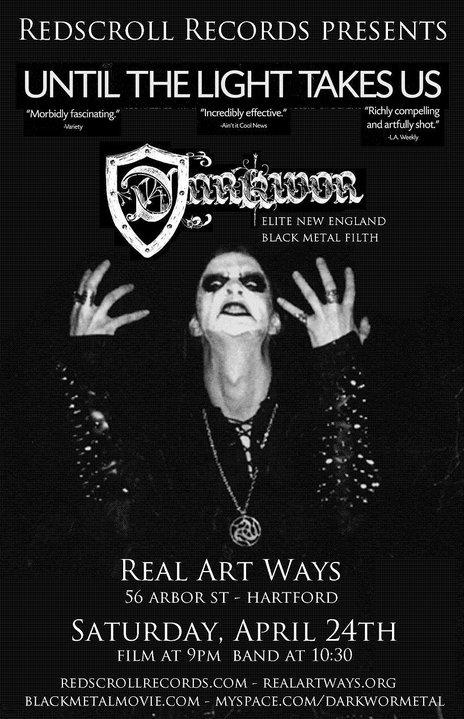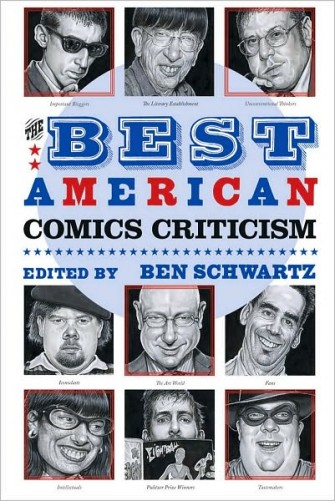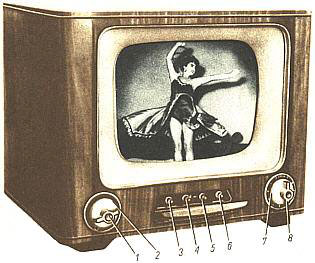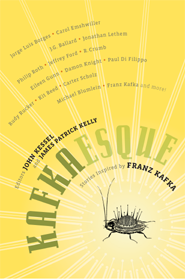Back in 2007, after the release of You Don’t Love Me Yet, I was fortunate enough to “silently interview” Jonathan Lethem (I emailed him the questions and he responded in email).
Mr Lethem was a remarkably generous conversationalist, and his answers were lovely — well-thought and well-formed. I wasn’t sure what would interest him, so I sent very disparate prompts on everything from literacy to comics to postmodernism. The coherence of this interview is entirely due to his thoughtfulness.
Thanks to bizarre editorial preferences, however, the full interview never saw the light of day, until now. Lethem comments at one point about things you write on the Internet coming back to haunt you; I hope if he notices this he’ll be pleased with what he wrote. I think it’s more the Return of the Impressive.
======================================
Caro: Since I’m in DC and you’re a known baseball enthusiast, got anything safe to print about the Washington Nationals?
JL: I fear not, but I’ll risk it. As a lifelong Mets fan I grew up feeling dread and fascination with the Montreal Expos, who tended to torment us, especially a now-mostly-forgotten cluster of players — Tim Raines, Floyd Youmans, Andres Gallarraga, etc. The whole Francophone thing, the obscure swirling logo on their caps, the name bound in time to some mysterious public event… all combined to make the Expos a source of wonder. The Nationals, by contrast, remind me in their flat, grey, literal existence of the “Washington Generals” (as opposed to the “Specifics”?), the basketball team destined to lose every night to the Harlem Globetrotters. I do like Dmitri Young, though.
Caro: I feel a little obligated to ask you about book festivals [Note: this interview was conducted in conjunction with Lethem’s appearance at George Mason University’s book festival]. I’m wondering if you have any thoughts on the value of putting authors and readers together in festival settings or on the state of literacy in the US in general?
JL: Ah, well, that’s a big question, literacy. I tend to worry about blowing a lot of hot air if I generalize about something like literacy, except to say that I’m in favor of it, fortunately find it everywhere I go, and therefore prefer to believe rumors of its demise are overstated.
As for festivals, all jokes aside, I really do like greeting other writers, and readers too. There’s a tension in this passion of ours, between the fundamentally solitary acts of reading and writing, the completely beautiful monastic tendencies that those activities cultivate in us, and then the countervailing urge to gather, come out of our shells, rediscover the tribal world, exchange enthusiasms, autograph one another’s first editions, brag and complain, talk about baseball, etcetera. I’ve always felt this double-urge very strongly, and I suppose my life can partly be described as a series of attempts to bridge the gap between the solitude of my private obsessions and the embrace of a larger human world — from working in bookstores, where I could meet other readers and press my favorites on them, to publishing my novels and then going out to thank personally the odd folks who liked them. Festivals are a nice opportunity to, again and briefly, resolve the public-private paradox.
Caro: You Don’t Love Me Yet is set in LA even though you are now, given your two best-known books, strongly associated with New York. Did you set this book in LA because you felt it was more appropriate, or more metaphorically significant, or just imaginative tourism?
JL: I lived in California for ten years before returning to Brooklyn — though I lived in Northern California, which in its way is as different (and as pitted-against) Los Angeles as New York is. And during that time everything I wrote was more or less set either in the Western part of the country — the Bay Area, or the desert west — or in a kind of vaguely gritty urban cartoon. You Don’t Love Me Yet actually felt like a return, to me, to the settings and modes of some earlier work, most particularly a book called As She Climbed Across The Table (as well as more recently unBrooklynish short stories like Vivian Relf). But I do understand that for a certain readership I “begin” with Motherless Brooklyn and then continue in The Fortress of Solitude, and that for those readers it may have come as a sort of shock, not just because of Los Angeles but because of the relatively blithe comic tone. I suppose I was willing to provide a u-turn experience for those members of my audience (assuming they were willing to follow me into the new territory, which is never something one should take for granted), just as I’ve felt willing — and sometimes even driven — to disappoint earlier expectations that I “stay” a hard-boiled detective writer, or a science fiction writer, or a postmodern writer, or whatever.
I landed in Los Angeles rather than the Bay Area — which would have been the more obvious home for a novel about hapless hipsters in their late twenties, seeing as how that was where I was when that was more or less who I was, but I realized that after the Brooklyn work — not just the two novels, but the constellation of essays and stories that surrounded them — I wanted to avoid the air of personal reminiscence even more completely. Rather than relying on the flavor of my memories of a place, I liked Los Angeles for being a place I was merely curious and confounded by. I felt free to write into my own perplexity about the way L.A. works because these characters are themselves perplexed (just as I felt safe writing about high-end particle physics in As She Climbed Across The Table because my characters are befuddled by physics).
Caro: LA’s media-saturated, less-than-intellectual culture is often credited with our society’s turn away from verbal literacy toward audio-visual media. It’s not uncommon for writers and teachers of writing to consider the proliferation of non-verbal media as bad for traditional verbal literacy (although there are different literacies at work). Do you think audio-visual literacy impedes verbal literacy, or is it just a matter of access and practice?
JL: Oh, big questions about literacy again! I’m terribly interested in your remarks here but fear I can’t do them justice in brief. Why don’t I just make a mysterious gesture in their direction by saying — yes, absolutely, yes: “different literacies,” even within the notion of a “visual literacy” – for instance, I’ve become hugely curious about the enormous differences in the ‘reading protocols’ that distinguish film spectatorship from comic-book reading – despite the great temptation, indulged everywhere lately, to conflate the two. One is passive and collective, the other so elaborate and private – and difficult, because of the necessity of constantly switching from verbal to visual presentation – that it may in fact be more hermetic than traditional reading. And, though I’ve never made myself familiar with it, I bet video game literacy is another thing altogether.
Anyway, I’d hardly be the first person to note that the great irony of cyberspace is that everyone’s using it to revive the epistolary tradition… e-mail (which we’re using now) was hardly the revolutionary post-literate virtual reality everybody was so hot for and frightened of fifteen years ago… but it is a revolution, isn’t it?
Caro: What prompted you to take plagiarism and originality as your subject in You Don’t Love Me Yet? And why did you choose alternative music as the place to work this out rather than, say, hip-hop, where appropriation is so much more direct and obvious?
JL: Great question. For the record, I once did, long ago, try to write a story about appropriation issues in hip-hop — this was around the time that Vanilla Ice was being compared to Elvis Presley for his usurpation of black cultural authenticity — and I failed. My attempt became a science fiction story about basketball players who appropriate one another’s skills using digital technology, so that a new player could “sample” Michael Jordan — it was a sort of disguised hip-hop story. And — continuing to feel defensive — I have no particular aversion to hip-hop. I feel the need to specify this because my semi-autobiographical character in Fortress of Solitude, Dylan Ebdus, is a sort of purist about soul music and has a great discomfort with rap. Not me, though. Yet somehow I’ve never managed to write about it very embracingly or extensively. It’s one of those things that just doesn’t seem, despite my interest, to be “mine” to write about. Like – ha! – Los Angeles.
Anyway, I had a whole bunch of other reasons to want to write about a mediocre rock band. I didn’t think of myself as having something to say about the ‘alternative scene’ (by the way, since since you mentioned scare quotes, I feel obliged to use them everywhere) in any real sense – this book simply doesn’t take place in the real world in that sense. But a rock band – two guitars, bass and drum – seems to me some kind of homely and encompassing archetype of the urge to blend artistic aspiration and hanging out with your friends – to refuse to choose between the two. And that interests me very much.
Caro: I’m not sure I have the chops to ask this question but I want to ask you about comic books as a literary influence because one of the things that I find myself as a adult not liking about comic books is how disruptive they feel in contrast with reading prose.
But highly literate people who love comics don’t seem to experience this the same way – there’s a deftness at balancing the multi-media form. Reading a comic seems to wish for a more seamless experience that takes a particular kind of literacy to really accomplish. Do you think art and words do inherently different literary work, or do they just work on the reader in different ways?
JL: Actually, I think I want to disagree with you directly here (and this is a distinction I began making in an earlier reply, above): For me, comic books are actually a very disrupted and baroque kind of reading experience, with uneasy shifts between simultaneous languages, and interesting tensions created between levels of ‘reality’ – the cartoonish and the mimetic coexisting – and it is in those kind of disruptions and discomforts that I find comic books most directly influencing my own art. (This is, again, as opposed to cinema, which seems to me a language of seamless immersion, imitative in that regard of waking reality, or dream – and, of course, interesting to and influential on me as well!)
Caro: You’re one of these literate people who love comics, but you have written several long and completely un-illustrated books in quite meaningful prose that take our cultural and personal engagement with comics and other art forms – music, film — as starting points. How do you feel about projects where someone makes a graphic novel out of a prose book, like with Auster’s New York Trilogy? Are they two ways of telling the same story or just a post-literate Cliff’s Notes?
JL: Well, yeah, much as I love that trilogy, that adaptation always seemed a bit dignified and literal to me — for the same reason I was never much of a reader of Classics Comics, and I mostly don’t like doggedly faithful middlebrow film adaptations of novels regarded as important. When one form takes from another I mostly prefer it to be a more fugitive and irreverent relationship, with stuff discarded or hidden, with slippages and rough edges showing. More energy and uncertainty. I’d love to see what would happen, for instance, if Paul collaborated with a comic book artist on something new, from the ground up.
Caro: From comics to lyrics: In your review of The Ground Beneath Her Feet for the Village Voice you say Rushdie’s lyrics “die on the page.” Lyrics play a pivotal plot point in You Don’t Love Me Yet — but not as quotes. Do you think quoting always has this death-effect on language that lives in another context? When you pull from a context that isn’t prose — lyrics or comics — what needs to happen to that language in order for it to not “die on the page?”
JL: Ah, this is the horror of the internet – ‘the return of the repressed’. I wish I hadn’t written that review. I’ll console myself by imagining that every writer has one such regret in his catalogue somewhere. The point I was snottily and overconfidently advancing is one that still concerns me: the difficulty of presenting one work of art within another, persuasively. Yet the evidence shows that I’m compelled to go up against this seeming impossibility. Rock lyrics have been, for me as a reader, a particular sticking point, even in books, like Delillo’s Great Jones Street, or Shiner’s Say Goodbye, that I find otherwise pretty beguiling. For that reason, I suppose, I chickened out and only quoted fragmentary lyrics in You Don’t Love Me Yet — and not even many of those. Mostly I just dropped the titles of my fictional songs and allowed the reader to imagine the rest. But I also believed I was safeguarding myself (perhaps wrongly) by asserting the mediocrity and marginality of my band – I didn’t claim they’d conquered the world, or even the pop charts. It’s that claim, for fictional art – that it changes the course of culture – that I usually find the most problematic and unpersuasive, like the presence of a “555” prefix in a phone number. And this is from a writer, and reader, not usually terribly concerned with verisimilitude. But we all have our sticking points.
Caro: In an interview with Robert Birnbaum in The Morning News you mention your “postmodernism” in scare quotes and emphasize your traditionalism. A sense of history and place doesn’t often provoke the adjective “postmodern,” so I’ve grabbed onto that as a traditional element in your work — you describe it as something that you had to learn by reading less-postmodern authors. Have you self-consciously tried to balance the influence of writers like Coover and Calvino an Angela Carter and those imaginative writers who created what came to be known as postmodern writing with the influences of modernism?
I’m also thinking of the way you mention elsewhere that a notion of “realism” that doesn’t take imagined reality into account isn’t really very realistic. Also in that interview with Birnbaum you say, “in Fortress of Solitude, the superhero is the metaphor that breaks out of the metaphorical and runs amok, distorting the reality.” It seems like metaphor is a much more useful and descriptive concept than “realism” for talking about the distorted way we experience the world. Questions of whether your work is realist or not seem to elide these postmodern influences and your sensitivity to metaphor and how we make our world through cultural engagement. I want to take that quote as saying that reality is itself richly metaphorical but let me prompt you to say more on how a metaphor “breaks out of the metaphorical.” Does it become something else, no longer a metaphor?
In all these dichotomies and contrasts — metaphor against reality, intellectual against inspiration, postmodern against traditional, audiovisual against verbal, LA against NY — the begged-but-not-mentioned one is fragmentation against synthesis: your essays are very synthetic and your novels do try to say something about history, something meaningful about race and class and experience and the way people make sense of the world. In that same interview with Birnbaum you say American writing “gobbles contradiction” — do you mean that it feeds on it or that it makes it evaporate?
JL: Can I say “both”? It gobbles it as it evaporates? I love all these remarks of yours, I should say first of all. Any answer I give here, in this brief form, is destined to be inadequate. But a few observations: yes, I’m quite devoted to the notion that the dreamlife is also life, and that the exclusion of reverie, daydream, hallucination, paranoid or reverent irrational belief, wishful distortions, needful projection, art projects, and other distortions of the ostensible ‘literal’ everyday surface of reality results — to the extent that my straw man actually exists — in a ‘realism’ that is not only impoverished, but by my standards quite utterly unreal. In fact it makes for a kind of kabuki notion of the real, highly mannered and communicating as mimetic only within certain very local and temporal formal traditions. In time such narrow notions of mimeticism may look as silly as, say, the huge prevalence of a bogus jiggly ‘documentary’ camera style in nearly all serious Hollywood films of the past five years, regardless of their subject.
But then again, I’m quite committed — to glance, for a moment, at the evidence — to a choice that is itself mannered, specific, and funky, and I’d be guilty of obfuscation if I seemed to be claiming that my work simply (or “simply”) represented a fuller and more “real” “realism”. That is to say, the metaphor that breaks out of the metaphorical — the magic ring or spray-can that makes lost things visible or goat man in my work — for shorthand, let’s call it my goat man. My goat man is a deliberate affront, a textual problem, an area of slippage or fissure between the use of an (generous and florid) mimeticism elsewhere and the objectionable, suspiciously genre-activating chunk of fantastic stuff — a character or object or environment that blurts out of the category of symbol or metaphor, into the story itself, and demands to be recognized. The chunk of cognitive dissonance my customers are always finding in their soup spoons. For that I can offer no explanation briefer than my collected works themselves. That pursuit is the tail I am forever chasing, and it is my own tail, and whether you find my effort ludicrous — like a puppy on the lawn — or enthralling and terrifying, like the Worm Oroborous (check the spelling on that) depends on your set and setting, I suppose. If I have anything, ultimately, to add to the great conversation of literature, it is this habit of deliberate confusion.
Caro: Paul Auster and Robert Coover have both come up in this email and both, like you, have a thing about baseball. Is there something inherently literary about baseball?
JL: Well, sure, many things. And they’ve nearly all been remarked upon here or there. But one I don’t think I’ve seen clearly identified is baseball’s tendency, with its schematic base-to-base, one-thing-at-a-time, let’s-stop-and-talk-it-over tendencies, to create a strong feeling of missed opportunity, lost chance, alternate outcome thoughts in the viewer. Whereas other sports are largely about things that actually happen, a lot of baseball ends up being about things that almost happened, that could have happened, but didn’t. It’s full of speculation and regret. Stories, in other words.
Caro: Although you have put girls at the center of your stories (Pella Marsh in particular), you have been often concerned with boyhood, with male coming-of-age as mediated by popular art. I heard someone refer to you once as the Francois Truffaut of books (which I interpreted to be because you find boys fascinating but aren’t incapable of doing justice to girls.) You do get asked a lot of those Questions-That-Are-Good-To-Ask-Smart-Men about race and class and popular culture and comics and magic realism: I would like to ask you about girls. Girls in popular culture, girls in literature, girls in your literature. The Mother Jones article on sexism in comics. Whether feminine coming of age is mediated by popular art in the same way as for boys…really just a general prompt.
JL: Let me again be defensive: before I’d written The Fortress of Solitude, I remember seeing an entry on me in some literary encyclopedia that defined my accomplishment (on the strength of As She Climbed Across The Table and Girl In Landscape, surely) as “strong female characters”. That’s a reputation I’d love to imagine I’ve burnished with You Don’t Love Me Yet. But of course the two Brooklyn books are also both books of male comraderie and female exclusion. No doubt in those books, and in some stories, I’ve explored the Hemingwayesque theme of “men without women” (and you’d be safe enough adding “men who don’t deserve women.”) And then the whole comic book and rock and roll thing may have reinforced the impression (though I don’t know the Mother Jones article you mention). But hey, wait, I didn’t write about “masculine coming of age” per se in my essays-cum-memoir — I simply wrote about my own! It wasn’t a sociological book, but a confessional one.
Caro: What would happen if Jack Kirby and Jack Kerouac showed up on your doorstep expecting…something?
JL: Jack Kerouac I’d simply want to offer soup and a sandwich, maybe a shoulder to cry on. That would be relatively simple. Kirby could get more complicated. We’d have a lot of stuff to talk over. Kirby frightens me a little.






